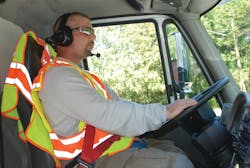University of Extrication: Safe Parking – Part 8
SUBJECT: Safe Parking – Part 8
TOPIC: Exiting Vehicles at Roadway Incidents
OBJECTIVE: Given an emergency response vehicle positioned at a simulated highway incident, the driver/operator will describe then demonstrate safe procedures for exiting the vehicle
TASK: From a seated and belted position in the driver’s seat of a parked emergency vehicle, the driver/operator will exit the vehicle following recommended safety procedures.
Previous articles in this University of Extrication Safe Parking series have addressed many different aspects of operating safely when working in or near moving traffic. Topics such as wearing high-visibility apparel, apparatus and ambulance positioning, and the requirements for advanced warning at these unplanned traffic-related events have been discussed. One aspect that is fundamental to everything we do at a highway emergency scene is to exit the vehicle we arrived at the scene in. Part 8 of this series on Safe Parking takes a detailed look at the recommended steps that should be followed by the vehicle driver to ensure that your exit keeps you as safe as possible.
When a vehicle arrives at a highway incident, the driver positions it according to the situation. Frequently, the situation requires the driver’s side of the vehicle to be exposed to upstream, approaching traffic. As such, the driver is exposed to a greater degree of risk when exiting their vehicle.
Our scenario has us arriving as the first-due apparatus at an injury crash. The incident is obstructing the shoulder and the right-most lane of a multi-lane highway. Because the crash is on the right, our rig is positioned in a “block to the left” angle; tailboard to the shoulder and cab of the vehicle towards the left. This positioning takes out the obstructed lane plus 1. The plan is that the other open lanes of traffic, Lanes 2 and 3, will be used to allow approaching traffic to move past the incident.
In this block position, the officer and all members riding in our crew area can and should exit out the right side of the vehicle, the protected side. It is the driver who must exit into the higher risk, zero-buffer area. A zero buffer area is defined as the area at a highway incident scene where the personnel are closest to moving traffic, have the greatest exposure risk, and have the least opportunity to escape from the path of a stray vehicle. In our block-to-the-left scenario, the zero buffer is the driver’s front corner of the apparatus bumper and the driver’s side of the cab.
In step-by-step images, here is a recommended best practice technique for exiting a responder vehicle when the exit pathway places the individual in a zero-buffer situation. Our scenario utilizes the driver’s position but the same procedures can be applied to any responder vehicle occupant who exits into a high-risk, zero-buffer situation in any type of vehicle – car, van, pickup truck or emergency apparatus. This simple protocol should be memorized and practiced by all responder personnel until it becomes “muscle memory,” a condition where the responder follows the proper procedure correctly every time, without even being consciously aware that they are doing it.
TASK: From a seated and belted position in the driver’s seat of a parked emergency vehicle, the driver/operator will exit the vehicle following recommended safety procedures.
